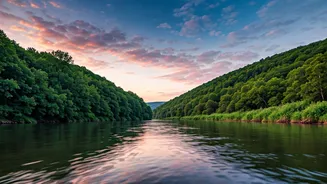Jogimara and Sitabenga
The Jogimara and Sitabenga Caves in Chhattisgarh are among the oldest in India, offering glimpses into ancient art and dramatic historical times. They
are particularly famous for their ancient rock-cut art and inscriptions that provide valuable information about the cultures of the time. The Jogimara Caves, in particular, showcase early artistic expressions and are believed to have been created around 300 BC. The Sitabenga Caves are known for their association with ancient theatre and performance spaces, offering visitors a unique perspective on ancient performance arts. Both sites present a glimpse into the Mauryan period, with inscriptions reflecting early Brahmi script. Visitors to these caves can marvel at the rich historical artifacts and understand the early forms of the Indian civilization. These caves are not just archaeological sites; they tell stories of artistry, drama, and cultural exchange that occurred centuries ago. Exploring them gives a deeper understanding of the artistic and cultural landscape of ancient India.
Badami Caves, Karnataka
Badami Caves, located in Karnataka, are a testament to the architectural and artistic prowess of the Chalukya dynasty. These caves, carved into a sandstone cliff, showcase a harmonious blend of Dravidian and Nagara styles of architecture. They feature intricate carvings and sculptures depicting Hindu gods and goddesses, such as Lord Shiva, Lord Vishnu, and the Jaina Tirthankaras. The caves provide a fascinating view of the religious tolerance and artistic achievements during the Chalukya rule. The first cave is dedicated to Lord Shiva, with his various forms displayed through impressive sculptures. The second cave is dedicated to Lord Vishnu, showing scenes from his life and various avatars. The third cave is also dedicated to Lord Vishnu and has detailed carvings. The fourth cave is devoted to the Jain faith and displays the images of Tirthankaras. These caves are not just mere structures; they also reflect the religious diversity and artistic development of the region, showcasing the rich cultural heritage of the Chalukya kingdom.
Pandavleni Caves, Maharashtra
The Pandavleni Caves, also known as the Nasik Caves, are located near Nashik in Maharashtra. These rock-cut caves are an important example of early Indian rock-cut architecture, dating back to the 3rd century BC to the 3rd century AD. The caves were originally created by the Hinayana sect of Buddhism, and later were occupied by other sects like Mahayana. They are known for their simple yet elegant design, showcasing the influence of Buddhist art and architecture. These caves consist of several chaityas (prayer halls) and viharas (monasteries). The architecture is remarkable, with pillars, sculptures, and inscriptions that provide valuable insights into the social and religious practices of ancient times. The Pandavleni Caves are important examples of early Buddhist cave architecture in India. They show the spread of Buddhism and its influence on art and architecture during that period. The caves provide a tranquil and reflective environment for visitors who wish to explore India's Buddhist past, providing a better understanding of the cultural and religious importance of ancient India.
Udayagiri and Khandagiri
Udayagiri and Khandagiri Caves are located near Bhubaneswar, Odisha, and are famous for their remarkable rock-cut architecture. These caves were mainly built by the Jain monks in the 2nd century BC. They are notable for their intricate carvings and inscriptions, showcasing the art and architecture of the Kalinga period. The caves are a testament to the Jain faith and are essential for anyone seeking to understand the religious and cultural history of the region. The Udayagiri Caves feature various caves, with the Hathigumpha cave being especially significant for its detailed inscriptions. The Khandagiri Caves also offer a unique view into the ancient world, with several chambers and sculptures. The architecture and carvings provide insights into the Jain teachings, demonstrating the art forms and religious beliefs prevalent during that era. Visiting these caves provides a deeper appreciation of the region's historical and cultural heritage. They are a testament to the artistic skills and religious diversity of the ancient Kalinga kingdom.
Barabar Caves, Bihar
The Barabar Caves, found in Bihar, are considered to be the oldest rock-cut caves in India, dating back to the Maurya Empire (322–185 BCE). These caves, including the Nagarjuni Caves, are a remarkable representation of ancient Indian architecture and engineering prowess. They were initially built as shelters for the Ajivika sect, a religious movement contemporary to Buddhism and Jainism. The caves feature smooth, polished surfaces and are known for their unique acoustic properties. These ancient caves provide a special experience for anyone exploring their history. The interiors, with their intricate design, provide insights into the building techniques of that time. The caves' polished surfaces and the reverberating echoes add to the otherworldly and unique atmosphere. The Barabar Caves are a must-see for those interested in ancient Indian history, architecture, and religious practices. They offer a deep dive into the lives and beliefs of the Ajivika sect and provide a tangible link to India's rich past.


















